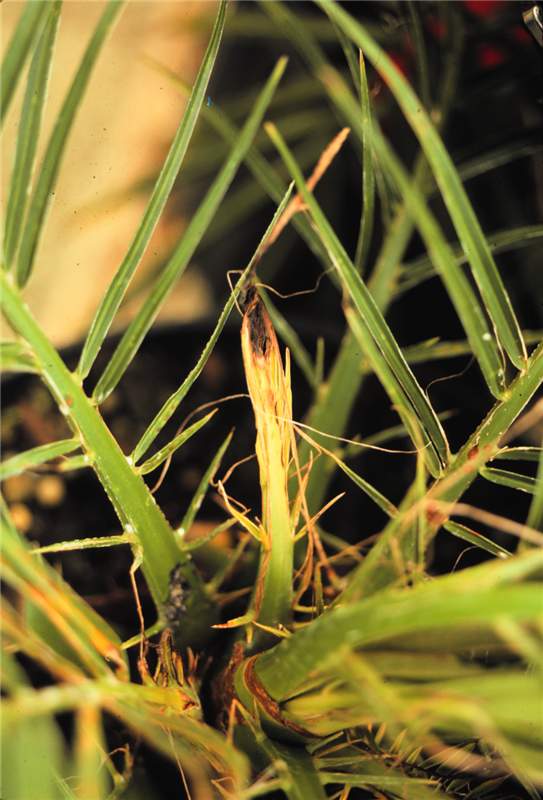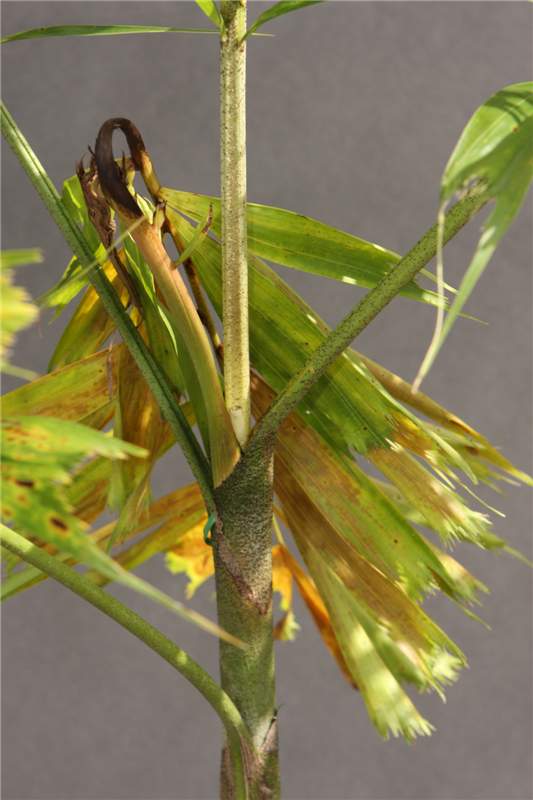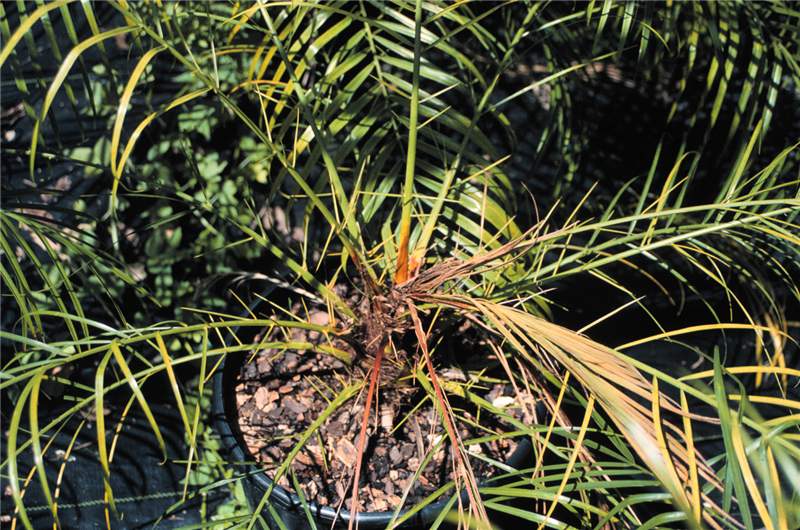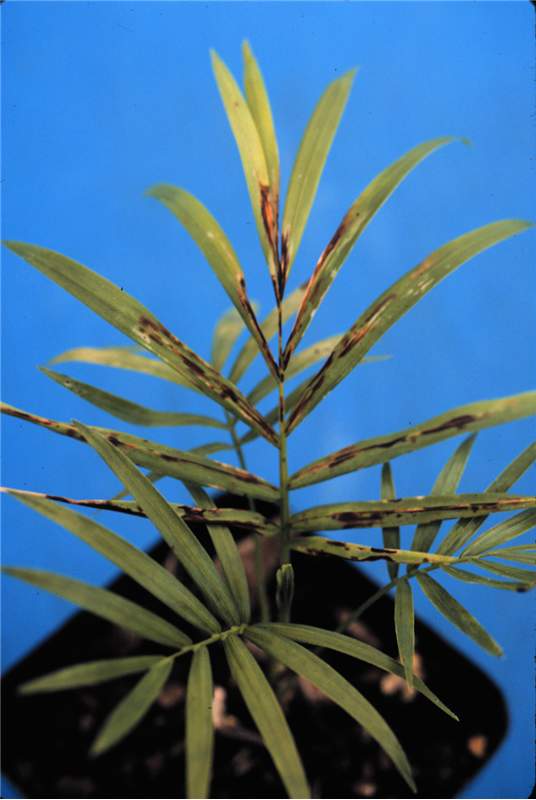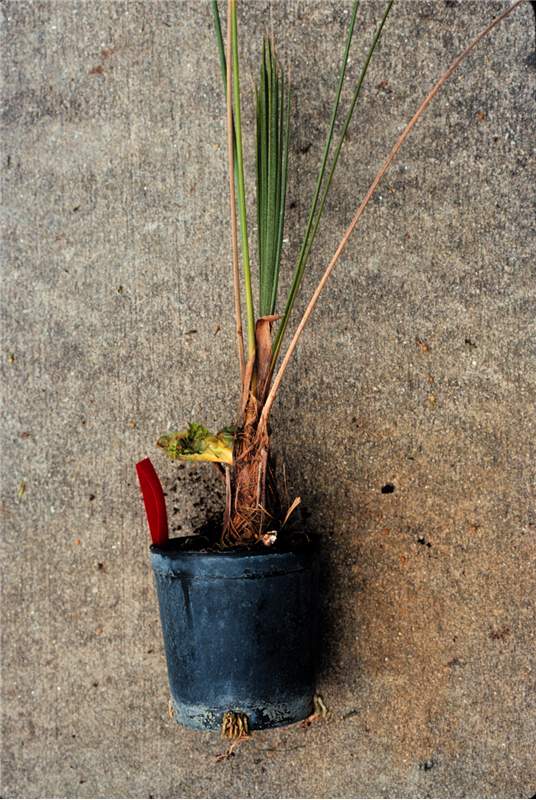Herbicide Toxicity
|
Figure 2. Glyphosate (Roundup) injury on Phoenix sylvestris. Photo by T.K. Broschat.
|
|
Figure 1. Glyphosate (Roundup) injury on Phoenix roebelenii. Note that the palm has since grown out of the injury. Photo by T.K. Broschat
|
|
Figure 4. Metsulfuron (Manor or Blade) injury on Wodyetia bifurcata. Damage became visible about 7 months following application to the soil. Photo by T.K. Broschat.
|
|
Figure 3. Metsulfuron (Manor or Blade) injury on Wodyetia bifurcata. Damage became visible about 7 months following application to the soil. Photo by T.K. Broschat.
|
|
Figure 6. Isoxaben plus oryzalin (Snapshot) injury on Phoenix roebelenii. Photo by T.K. Broschat.
|
|
Figure 5. Oryzalin plus oxyfluorfen (Rout) injury on Chamaedorea elegans. Photo by T.K. Broschat.
|
|
Figure 7. Metolachlor (Pennant) injury on Coccothrinax sp. Note branching in this normally single-stemmed species. Photo by T.K. Broschat.
|
Symptoms
Symptoms of herbicide toxicity vary with the class of herbicide used. Among postemergent herbicides, glyphosate injury appears as distortion and reduction in the size of new leaves (Fig. 1). New leaflets may show some necrosisnecrosis:
dead tissue, usually desiccated and brown to gray in color
(Fig. 2). Paraquat or diquat injury appears as desiccation of the foliage contacted by the herbicide. Phenoxy herbicides such as 2,4-D cause distortion of the foliage and contortion of petioles. Metsulfuron causes leafletleaflet:
divisions of pinnate leaves
puckering and necrosisnecrosis:
dead tissue, usually desiccated and brown to gray in color
of the central part of the rachisrachis:
the axis of a leaf beyond the petiole or an extension of the petiole into the leaf blade
. The distaldistal:
farthest from the point of attachment
portion of the leaf will drop down and may become necroticnecrotic:
see necrosis
(Figs. 3 and 4). Although these postemergent herbicides can be fatal, palms often outgrow these symptoms and eventually resume normal growth.
Preemergent herbicides typically cause injury to newly emerging foliage. Symptoms include new leaf dieback, chlorosischlorosis:
a loss of chlorophyll resulting in white, yellow, or orange leaf color
, stunting, and varying patterns of necrosisnecrosis:
dead tissue, usually desiccated and brown to gray in color
(Figs. 5 and 6). Death of the meristemmeristem:
the growing region of a plant, a special area of undifferentiated cells wherein new cells and organs are developed
is common. In palms treated with metolachlor, symptoms often include the production of side shoots in addition to new leaf stunting, necrosisnecrosis:
dead tissue, usually desiccated and brown to gray in color
, and distortion (Fig. 7). Large palms growing in landscapes can also be affected by preemergent herbicides, often fatally.
May be confused with
Symptoms of systemic herbicide injury can be confused with boron deficiency. Indeed, excessive auxinauxin:
plant hormone that regulates the amount, type, and direction of plant growth
levels are a characteristic of both B deficiency and phenoxy herbicide injury.
Cause
Herbicides applied to the foliage or soil can be absorbed by palms with variable results.
Occurrence
Injury due to preemergent herbicides is fairly common where these are applied to the soil of container-grown palms, but these products can also affect mature palms in the landscape that have been treated. Although some studies have shown certain preemergent products to be quite safe when used on palms at recommended rates, other studies have shown injury from these same products when applied to the same species at similar rates. High soil temperatures are believed to accentuate the toxicity of these products to palms. Postemergent herbicide damage is less common since these products are often used as directed sprays around the trunks of mature palms in field nurseries or landscapes and seldom contact the foliage. Most palms, Cocos nucifera in particular, are highly resistant to injury by glyphosate. Soil applications of metsulfuron can cause foliar injury.
Additional comments
Visual symptoms, plus a knowledge of treatment history, are needed to diagnose herbicide toxicity. Leaf analysis for suspected herbicides is sometimes used to confirm the presence of the herbicide in the foliage.


